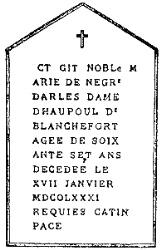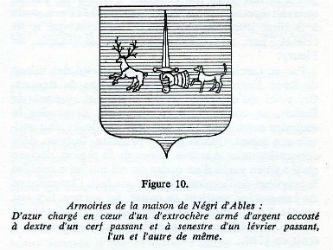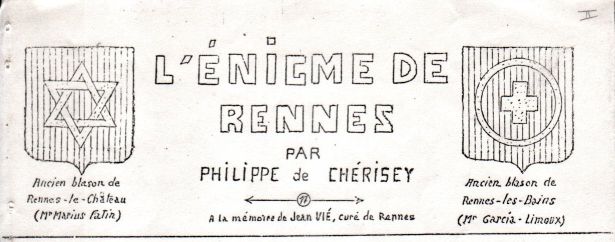Rennes-le-Château’s mysterious gravestone
A Chronology
Paul Smith
27 February 2017
Revised 3 February 2018
The gravestone of Marie de Negri d’Ables is one of the major pivotal elements of the fake Rennes-le-Château “mystery” (forever described as enigmatic by the conspiracy theorists).

Spelling mistakes on the epitaph of the gravestone produce the words “MORT épée” (Dead Sword), and the additional REQUIES CATIN PACE instead of REQUIESCAT IN PACE (Catin is slang for whore). This is not the only gravestone whose epitaph in the region contains spelling mistakes or bears REQUIES CATIN PACE.
Summarized chronology of the gravestone (that no longer exists).
17 January 1781
Death in Rennes-le-Château of Marie de Negre d’Ables, Marchioness of Hautpoul-Blanchefort
1906
Drawing of the gravestone of Marie de Negri d’Ables, described as cracked in the middle, in an article by Elie Tisseyre in the Bulletin of the Scientific Study of the Aude, relating to a visit to Rennes-le-Château in 1905. The title of the article states that the visit occurred on 25 June, while the article states 24 June.
1931
Offprint version of Elie Tisseyre’s article, deposited in the Municipal Library of Carcassonne, by “Marty”.
1962
Noël Corbu on a Radio Interview referred to the gravestone of Marie de Negri d’Ables as part of his “Rennes-le-Château mystery portfolio” but suppresses information about Elie Tisseyre’s 1906 article that gave a drawing of the gravestone. Instead, Corbu refers to a version of a gravestone that bore “REDDIS REGIS” as part of its inscription.
1965
Priory of Sion document attributed to “Madeleine Blancassall”, Les Descendants Mérovingiens ou l’énigme du Razès wisigoth, deposited in the Bibliothéque Nationale, describing the existence of two parchments, one of which contained the decoded “BERGERE PAS DE TENTATION” message, being almost an anagram of the epitaph found on the gravestone (PS Prae-Cum added). The beginning of the use of the epitaph to assimilate and absorb Pierre Plantard’s and Philippe de Chèrisey’s fake claims about Bérenger Saunière and Rennes-le-Château. This material was later incorporated into Gérard de Sède’s 1967 book, L’Or de Rennes.

1971
In his novella “Circuit” Philippe de Chérisey explained how he enciphered the text of the Large Parchment from the inscription on the gravestone of Marie de Negri d’Ables (Appendix: The Alibi of O, presented as a screenplay to a proposed film). Philippe de Chérisey also stated that the “BERGERE PAS TENTATION” decoded message referred to the paintings of Eugène Delacroix in the church of St Sulpice, Paris. The deciphered message is also developed into a fantasy story involving the characters CHARLOT and MARIE-MADELEINE, who discover a frightening treasure by the tomb of a Great Roman, indirectly inferring that it will one day be claimed by Pierre Plantard.
Circa 1973
In “Pierre et Papier” (Stone and Paper), Philippe de Chérisey explained how he developed a method of encipherment using as raw material the text of the Large Parchment from the grave of a female member of the Hautpoul-Blanchefort family, involving a transposition grid and a chessboard. (Philippe de Chérisey interviewed in Pégase, Number 5, October 1973, referred to “Pierre et Papier”)
1977
Publication of Signé: Rose+Croix: l'énigme de Rennes-le-Château by Gérard de Sède, the final revised edition of L’Or de Rennes. The book depicted Armoiries de la maison de Négri d’Ables.

If accurate, that a sword featured on the coat-of-arms of the de Negri family, it could thus explain the reference to Mort épée (Dead Sword) found on the epitaph – as well as to CATIN (Marie de Negri d’Ables died without producing any surviving male issue).
1978
Philippe de Chèrisey, L’Enigme de Rennes. Triggered by the publication of Gérard de Sède’s Signé: Rose+Croix, aiming negative criticisms towards book and author, de Chérisey claimed to have communicated with a “Monsieur MARTY” from Carcassonne, who wrote he was the owner since 1956 of the gravestone of Marie de Negri d’Ables.

Philippe de Chérisey reproduced 13 documents and letters in L’Enigme de Rennes but didn’t reproduce any of the letters he allegedly received from “Monsieur MARTY”. It’s more than likely that he invented this correspondence, the name coming from the “Marty” who deposited the offprint of Tisseyre’s article in the Municipal Library of Carcassonne in 1931.
2007
Gérard Jean, of the l'Académie des Arts et des Sciences de Carcassonne, validated the existence of the gravestone of the Countess of Blanchefort, adding that it had been taken away by “Marty” during the 1905 excursion to Rennes-le-Château with Elie Tisseyre. His family wanted to donate it first to the Musée Lapidaire de Carcassonne – then to the Academy – without success due to the gravestone not meeting the requirement type of relics that were accepted.
It remains to be seen if this gravestone really exists.
|



